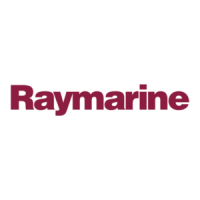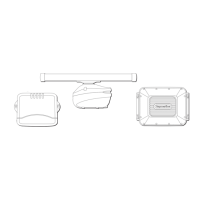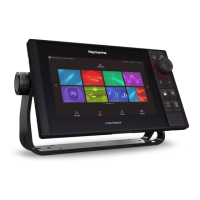Do you have a question about the Raymarine GPM400 and is the answer not in the manual?
General operating principles for G-Series applications, including menus and toolbars.
Using the system for Man Overboard (MOB) function and sounding warning alarms.
Explains the use of waypoints for navigation, marking locations, and building routes in G-Series windows.
Methods for placing waypoints at cursor position, vessel position, or specified coordinates.
How to start and stop navigating to waypoints, including active waypoint status and autopilot integration.
Modifying waypoint name, symbol, group, adding comments, moving, and erasing waypoints.
Emphasizes safe navigation, comparing chart display to surroundings, and not using chart as substitute for official charts.
Configuring chart display, including object information, vector length, track interval, and datum.
Using the GOTO softkey for simple navigation functions and placing temporary waypoints.
Creating and managing routes from existing or new waypoints in chart view or waypoint list.
Enabling and using tracks to show journey course, saving, and converting tracks to routes.
Controlling data display on chart windows, including show/hide waypoints, chart layers, and overlays.
Setting chart display modes (North Up, Heading Up, Course Up) and motion modes (Relative, True).
Using Navionics chart data for journey planning, including object details, port services, and aerial photography.
Emphasizes the 3D chart as a visualization aid, stressing safe navigation and comparison with normal charts.
Displaying standard and 3D chart windows side-by-side for enhanced confidence and information.
How to disable the autopilot by pressing the STANDBY button.
Steps to enable autopilot control and engage it via the Pilot Control pop-up window.
System actions upon reaching a waypoint in a route, including alarms and control screen display.
Configuring display mode settings like zoom, bottom lock, A-Scope, for each preset.
Adjusting gain modes, color gain, TVG, and color threshold for optimal fishfinder performance.
Methods for measuring depth and distance using depth readings, lines, target IDs, cursor depth, and VRMs.
Setting and configuring Fish Alarms and Shallow/Deep Alarms for the fishfinder.
General operating principles for G-Series applications, including menus and toolbars.
Using the system for Man Overboard (MOB) function and sounding warning alarms.
Explains the use of waypoints for navigation, marking locations, and building routes in G-Series windows.
Methods for placing waypoints at cursor position, vessel position, or specified coordinates.
How to start and stop navigating to waypoints, including active waypoint status and autopilot integration.
Modifying waypoint name, symbol, group, adding comments, moving, and erasing waypoints.
Emphasizes safe navigation, comparing chart display to surroundings, and not using chart as substitute for official charts.
Configuring chart display, including object information, vector length, track interval, and datum.
Using the GOTO softkey for simple navigation functions and placing temporary waypoints.
Creating and managing routes from existing or new waypoints in chart view or waypoint list.
Enabling and using tracks to show journey course, saving, and converting tracks to routes.
Controlling data display on chart windows, including show/hide waypoints, chart layers, and overlays.
Setting chart display modes (North Up, Heading Up, Course Up) and motion modes (Relative, True).
Using Navionics chart data for journey planning, including object details, port services, and aerial photography.
Emphasizes the 3D chart as a visualization aid, stressing safe navigation and comparison with normal charts.
Displaying standard and 3D chart windows side-by-side for enhanced confidence and information.
How to disable the autopilot by pressing the STANDBY button.
Steps to enable autopilot control and engage it via the Pilot Control pop-up window.
System actions upon reaching a waypoint in a route, including alarms and control screen display.
Configuring display mode settings like zoom, bottom lock, A-Scope, for each preset.
Adjusting gain modes, color gain, TVG, and color threshold for optimal fishfinder performance.
Methods for measuring depth and distance using depth readings, lines, target IDs, cursor depth, and VRMs.
Setting and configuring Fish Alarms and Shallow/Deep Alarms for the fishfinder.
| Brand | Raymarine |
|---|---|
| Model | GPM400 |
| Category | Marine GPS System |
| Language | English |











